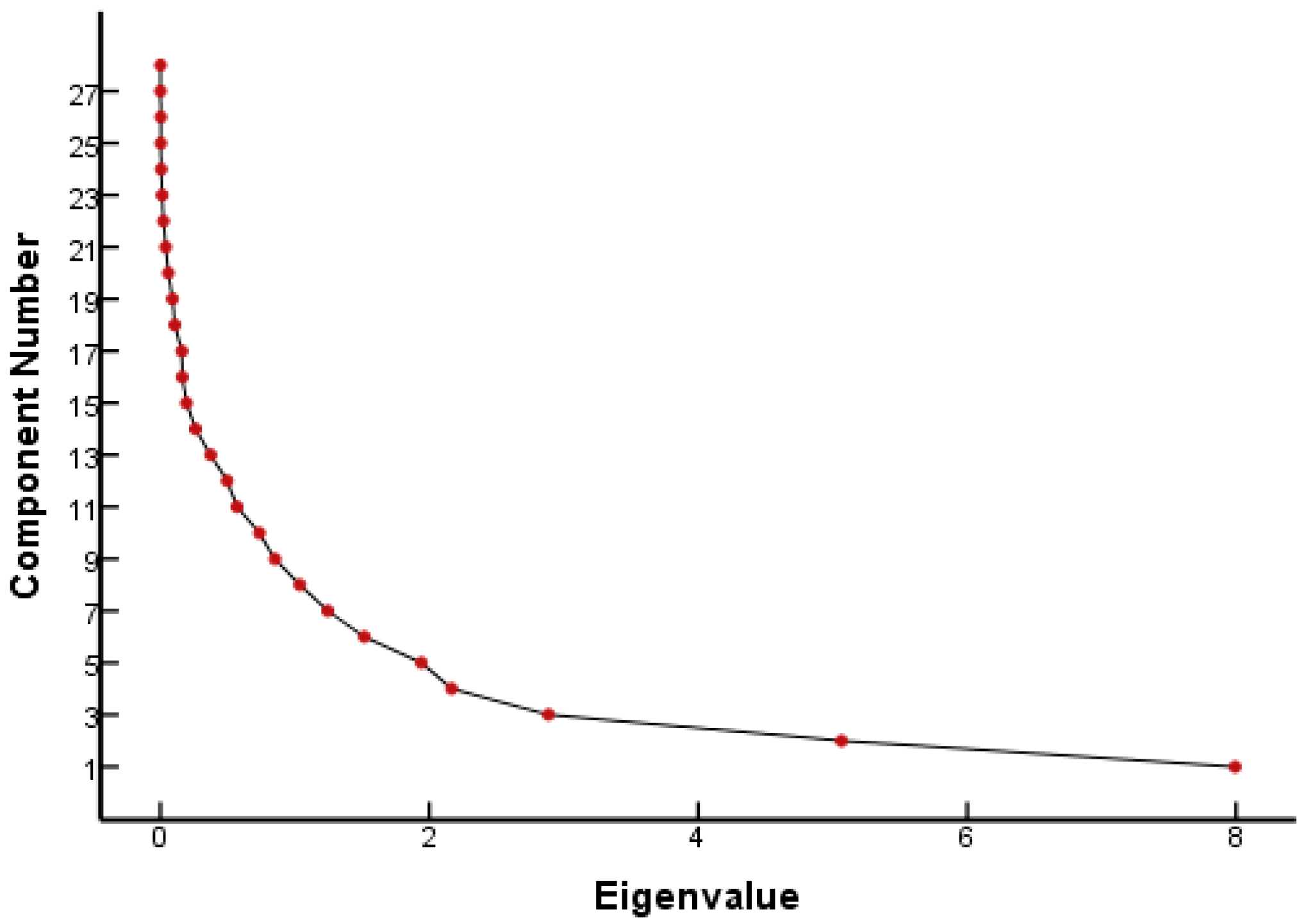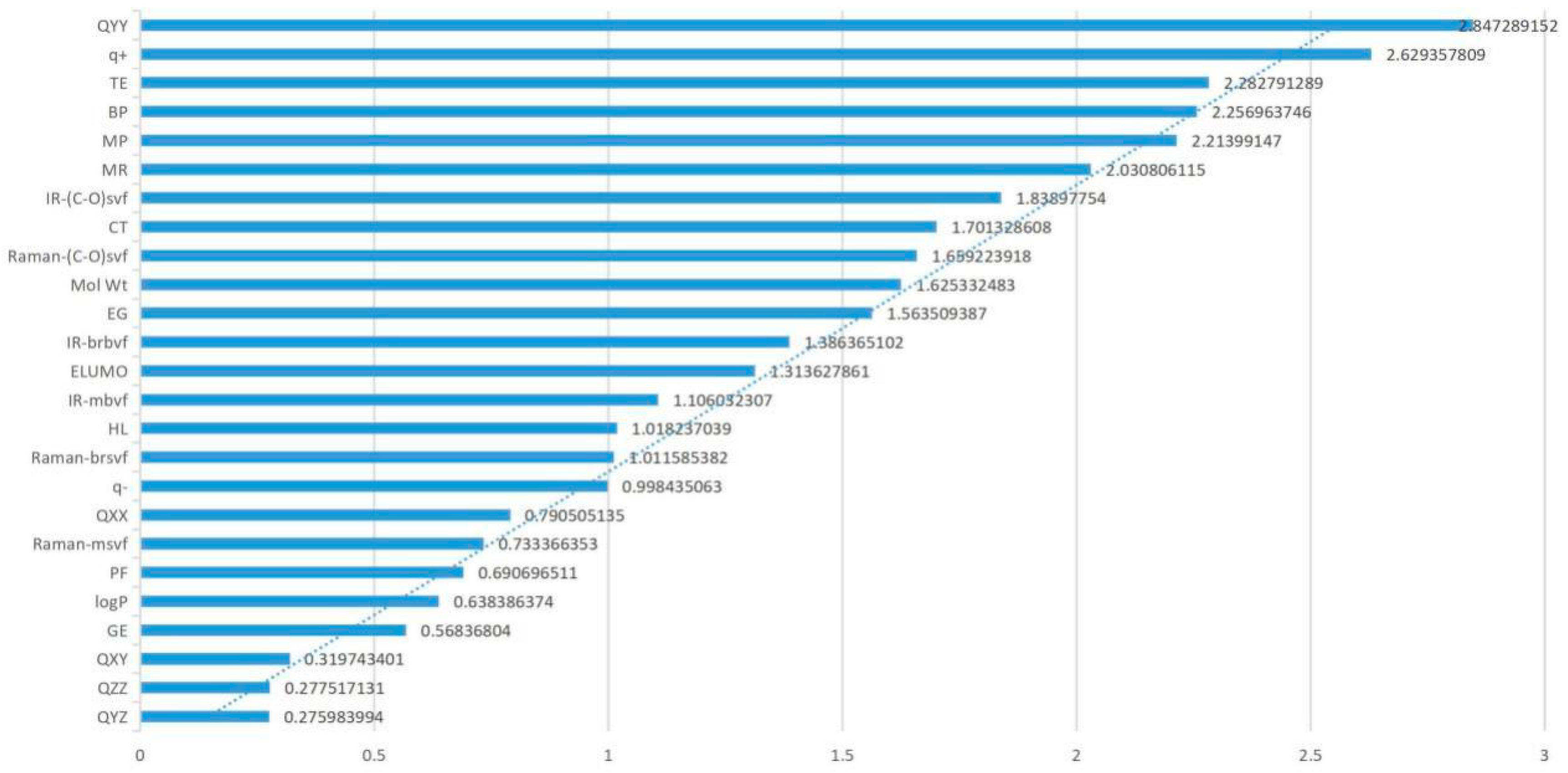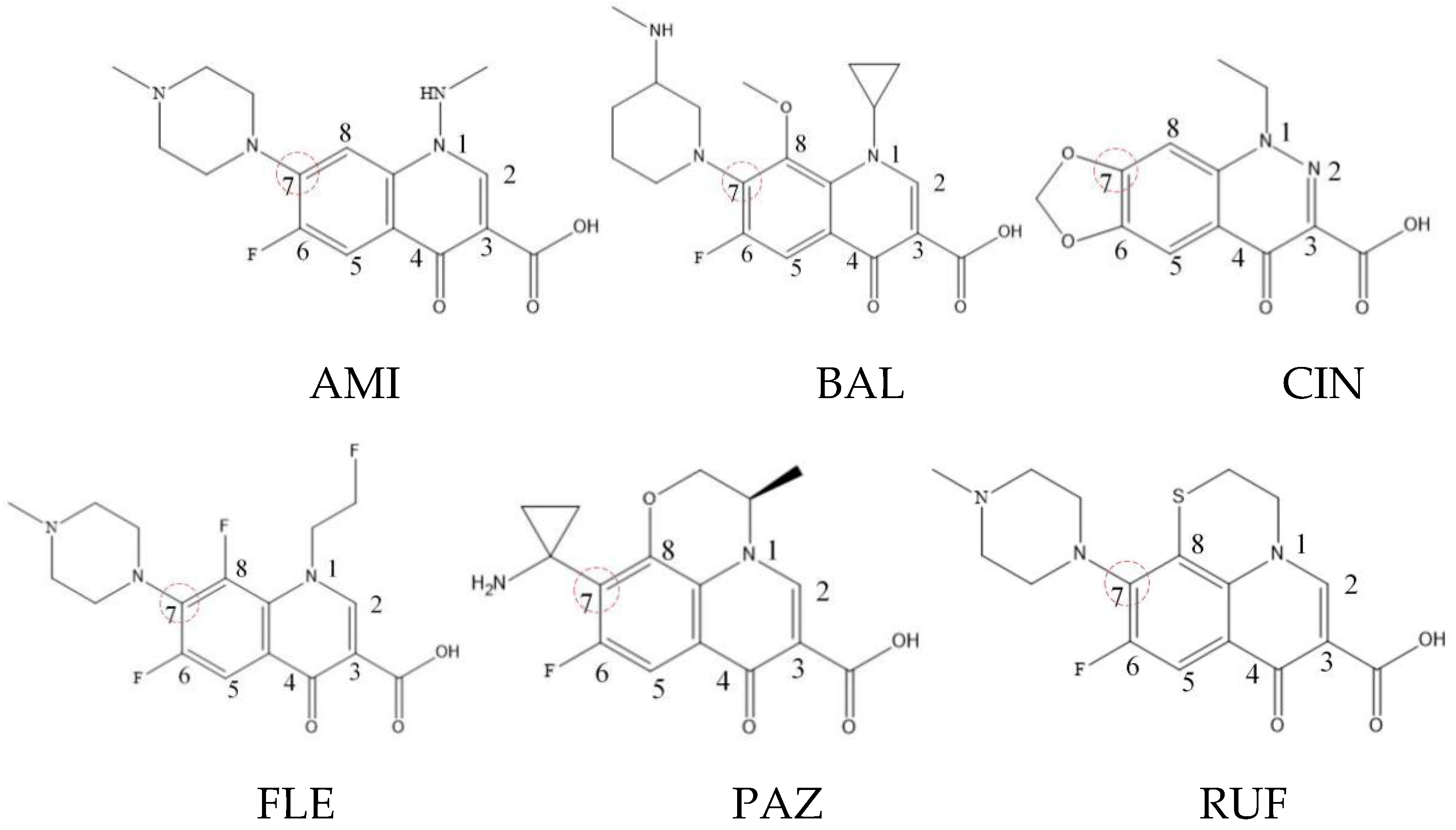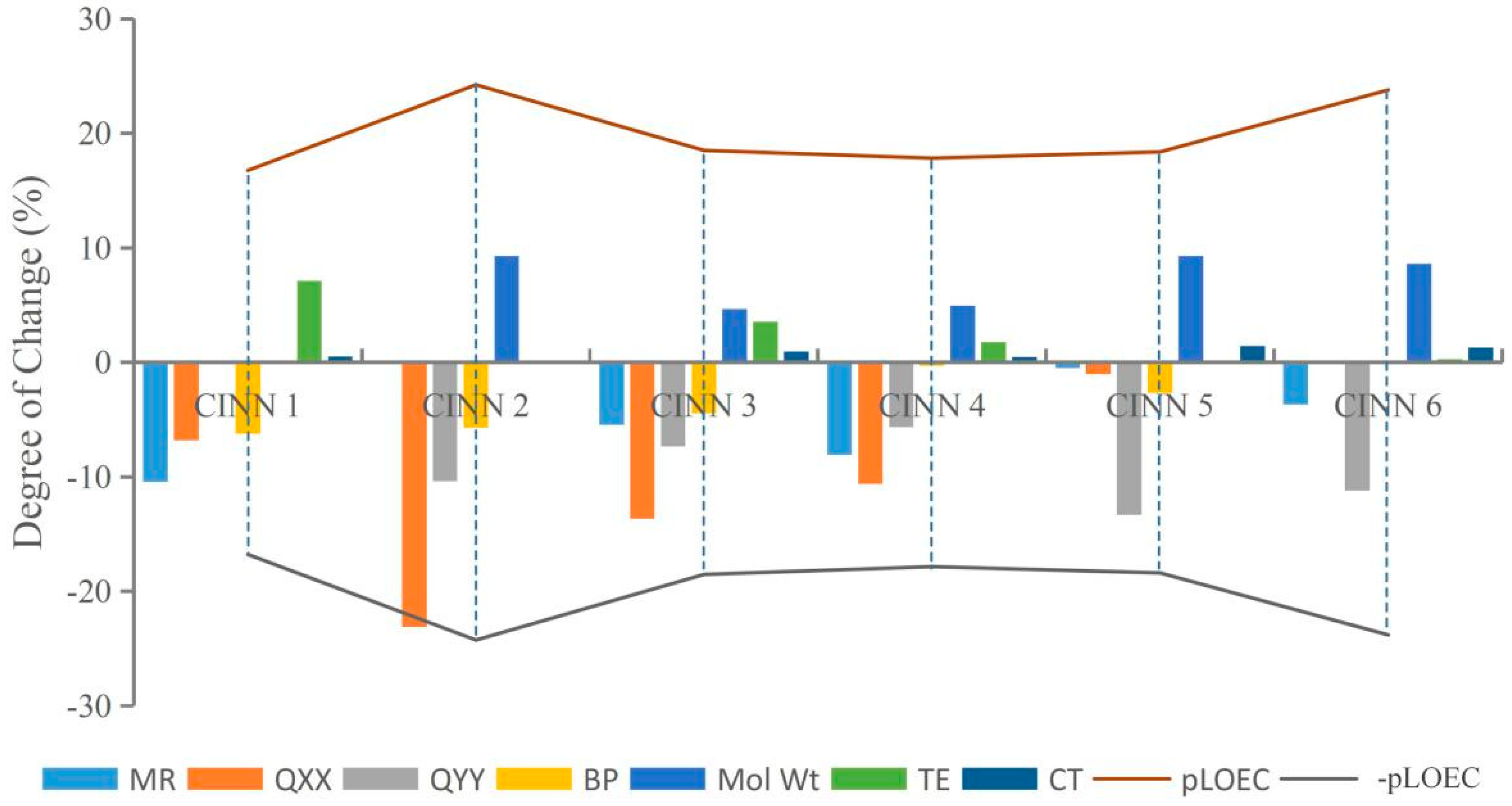Combined 2D-QSAR, Principal Component Analysis and Sensitivity Analysis Studies on Fluoroquinolones’ Genotoxicity
Abstract
:1. Introduction
2. Materials and Methods
2.1. Data Sources and Calculation Methods
2.2. D-QSAR Model Analysis Method
2.3. PCA Method
2.4. Sensitivity Analysis
3. Results and Discussion
3.1. Molecular Genotoxicity Analysis of FQs Based on the 2D-QSAR Model
3.2. Analysis of FQ Genotoxicity Based on Principal Component Analysis
3.3. Genotoxicity Parameter Verification of FQs Based on Sensitivity Analysis
3.4. FQ Genotoxicity and Mechanism Analysis
3.4.1. The Change Law of Molecular Genotoxicity of FQs
3.4.2. Correlation Analysis between the Main Parameters and Genotoxicity of FQ Derivatives and Their Tautomeric Forms
4. Conclusions
Supplementary Materials
Author Contributions
Funding
Acknowledgments
Conflicts of Interest
References
- Bosca, F. Seeking to shed some light on the binding of fluoroquinolones to albumin. J. Phys. Chem. B. 2012, 116, 3504–3511. [Google Scholar] [CrossRef] [PubMed]
- Wang, K.P.; Zhang, Q.Q.; Guo, J.S.; Xu, Q.Q.; Wang, Y.L. Review of the determination of fluoroquinolones in the environment and its removal from the sewage. J. Saf. Environ. 2012, 12, 104–110. [Google Scholar] [CrossRef] [PubMed]
- Leung, H.W.; Minh, T.B.; Murphy, M.B.; James, C.W.L.; So, M.K.; Martin, M.; Lam, P.K.S.; Richardson, B.J. Distribution, fate and risk assessment of antibiotics in sewage treatment plants in Hong Kong, South China. Environ. Int. 2012, 42, 1–9. [Google Scholar] [CrossRef] [PubMed]
- Vergnes, J.S.; Jung, R.; Thakur, A.K.; Barfknecht, T.R.; Reynolds, V.L. Genetic toxicity evaluation of octamethylcyclotetrasiloxane. Environ. Mol. Mutagenesis 2015, 36, 13–21. [Google Scholar] [CrossRef]
- Aldred, K.J.; Kerns, R.J.; Osheroff, N. Mechanism of quinolone action and resistance. Biochem. 2014, 53, 1565–1574. [Google Scholar] [CrossRef]
- Woodruff, R.S.; Li, Y.; Yan, J.; Bishop, M.; Jones, M.Y.; Watanabe, F.; Biris, A.S.; Rice, P.; Zhou, T.; Chen, T. Genotoxicity evaluation of titanium dioxide nanoparticles using the Ames test and Comet assay. J. Appl. Toxicol. 2012, 32, 934–943. [Google Scholar] [CrossRef]
- Arlotte, B.F.; Josef, M.D.; Riedler, M.D. Environmental exposure to endotoxinand its relation to asthma in school-age children. New Engl. J. Med. 2002, 347, 869–877. [Google Scholar]
- Boettcher, M.; Grund, S.; Keiter, S.; Kosmehl, T.; Reifferscheid, G.; Seitz, N.; Rocha, P.S.; Hollert, H.; Braunbeck, T. Comparison of in vitro and in situ genotoxicity in the Danube River by means of the comet assay and the micronucleus test. Mutat. Res. Fundam. Mol. Mech. Mutagenesis 2010, 700, 11–17. [Google Scholar] [CrossRef]
- Zhang, J.H.; Zhang, G.X.; Xu, M.Y.; Guo, J.; Sun, G.P. Technology study on detection of genotoxicity for water source. Environ. Sci. Technol. 2010, 33, 188–192. [Google Scholar]
- Yan, Y.; Jiang, W.W.; Li, N.; Ma, M.; Rao, K.F.; Wang, Z.J. Application of the SOS/umu test and high-content\r, in vitro\r, micronucleus test to determine genotoxicity and cytotoxicity of nine benzothiazoles. J. Appl. Toxicol. 2014, 34, 1400–1408. [Google Scholar]
- Isidori, M.; Lavorgna, M.; Nardelli, A.; Pascrella, L.; Parrella, A. Toxic and genotoxic evaluation of six antibiotics on non-target organisms. Sci. Total. Environ. 2005, 346, 87–98. [Google Scholar] [CrossRef] [PubMed]
- Shi, J.Q.; Qu, R.J.; Feng, M.B.; Wang, X.H.; Wang, L.S.; Yang, S.G.; Wang, Z.Y. Oxidative degradation of decabromodiphenyl ether (BDE 209) by potassium permanganate: reaction pathways, kinetics, and mechanisms assisted by density functional theory calculations. Environ. Sci. Technol. 2015, 49, 4209–4217. [Google Scholar] [CrossRef] [PubMed]
- Zou, W.; Luo, Y.; Zhou, Q.X. Pollution and environmental regulation of antibiotic resistance genes (ARGs) in Livestock Manure. J. Agro-Environ. Sci. 2014, 33, 2281–2287. [Google Scholar]
- Chen, B.; Yuan, K.; Chen, X.; Yang, Y.; Zhang, T.; Wang, Y.; Luan, T.; Zou, S.; Li, X. Metagenomic analysis revealing antibiotic resistance genes (ARGs) and their genetic compartments in the Tibetan environment. Environ. Sci. Technol. 2016, 50, 6670–6679. [Google Scholar] [CrossRef] [PubMed]
- Zhou, Q.X. Environmental residues and ecotoxicity of antibiotics and their resistance gene pollution:A review. Asian J. Ecotoxicol. 2007, 2, 243–251. [Google Scholar]
- Speltini, A.; Sturini, M.; Maraschi, F.; Profumo, A. Fluoroquinolone antibiotics in environmental waters: Sample preparation and determination. J. Sep. Sci. 2015, 33, 1115–1131. [Google Scholar] [CrossRef]
- Zhao, L.; Zhang, J.; Zheng, B.W.; Wei, Z.Q.; Shen, P.; Li, S.J.; Li, L.J.; Xiao, Y.H. Molecular epidemiology and genetic diversity of fluoroquinolone-resistant Escherichia coli isolates from patients with community-onset infections in 30 Chinese county hospitals. J. Clin. Microbiol. 2015, 53, 766–770. [Google Scholar] [CrossRef]
- Miravitlles, M.; Anzueto, A. Moxifloxacin: a respiratory fluoroquinolone. Expert Opin. Pharmacother. 2008, 9, 1755–1772. [Google Scholar] [CrossRef]
- Zeng, X.L.; Qu, R.J.; Feng, M.B.; Chen, J.; Wang, L.S.; Wang, Z.Y. Photodegradation of polyfluorinated Dibenzo-p-Dioxins (PFDDs) in organic solvents: Experimental and theoretical studies. Environ. Sci. Technol. 2016, 50, 8128–8134. [Google Scholar] [CrossRef]
- Amjadi, M.; Manzoori, J.L.; Hallaj, T.; Shahbazsaghir, T. Application of the chemiluminescence system composed of silicon-doped carbon dots, iron (II) and K2S2O8 to the determination of norfloxacin. Microchim. Acta. 2017, 184, 1587–1593. [Google Scholar] [CrossRef]
- Verma, J.; Khedkar, V.M.; Coutinho, E.C. 3D-QSAR in drug design-A review. Curr. Top. Med. Chem. 2010, 10, 95–115. [Google Scholar] [CrossRef] [PubMed]
- Du, M.J.; Gu, W.W.; Li, X.X.; Fan, F.Q.; Li, Y. Modification of hexachlorobenzene to molecules with lower long-range transport potentials using 3D-QSAR models with a full factor experimental design. Adv. Mar. Biol. 2018, 81, 129–165. [Google Scholar] [PubMed]
- Zhao, Y.Y.; Gu, W.W.; Li, Y. Molecular design of 1,3,5,7-TetraCN derivatives with reduced bioconcentration using 3D-QSAR modeling, full factorial design, and molecular docking. J. Mol. Graph. Model. 2018, 84, 197–214. [Google Scholar] [CrossRef] [PubMed]
- Wang, X.L.; Chu, Z.H.; Yang, J.W.; Li, Y. Pentachlorophenol molecule design with lower bioconcentration through 3D-QSAR associated with molecule docking. Environ. Sci. Pollut. Res. 2017, 24, 25114–25125. [Google Scholar] [CrossRef]
- Li, M.; Wei, D.B.; Zhao, H.M.; Du, Y.G. Genotoxicity of quinolones: Substituents contribution and transformation products QSAR evaluation using 2D and 3D models. Chemosphere 2014, 95, 220–226. [Google Scholar] [CrossRef]
- Villaverde, J.J.; Santín-Montanyá, M.I.; Morán, B.S.; Alonso-Prados, J.L.; Sandín-España, P. Assessing the effects of alloxydim phototransformation products by QSAR models and a phytotoxicity study. Mol. 2018, 23, 993–2006. [Google Scholar] [CrossRef]
- Qu, R.J.; Liu, H.X.; Feng, M.B.; Yang, X.; Wang, Z.Y. Investigation on intramolecular hydrogen bond and some thermodynamic properties of polyhydroxylated anthraquinones. J. Chem. Eng. Data 2012, 57, 2442–2455. [Google Scholar] [CrossRef]
- Granato, D.; Jânio, S.S.; Escher, G.B.; Ferreira, B.; Maggio, R.M. Use of principal component analysis (PCA) and hierarchical cluster analysis (HCA) for multivariate association between bioactive compounds and functional properties in foods: A critical perspective. Trends Food Sci. Technol. 2018, 72, 83–90. [Google Scholar] [CrossRef]
- Zakhem, B.A. Using principal component analysis (PCA) in the investigation of aquifer storage and recovery (ASR) in Damascus Basin (Syria). Environ. Earth Sci. 2016, 75, 1123–1138. [Google Scholar] [CrossRef]
- Yu, B.; Ning, C.L.; Li, B. Probabilistic durability assessment of concrete structures in marine environments: Reliability and sensitivity analysis. China Ocean Eng. 2017, 31, 63–73. [Google Scholar] [CrossRef]
- Xue, W. SPSS Statistical Analysis Methods and Applications; Publishing House of Electronics Industry: Beijing, China, 2009. [Google Scholar]
- Chen, Y.; Cai, X.; Jiang, L.; Li, Y. Prediction of octanol-air partition coefficients for polychlorinated biphenyls (PCBs) using 3D-QSAR models. Ecotoxicol. Environ. Saf. 2016, 124, 202–212. [Google Scholar] [CrossRef] [PubMed]
- Mostafaeipour, A.; Zarezade, M.; Goudarzi, H.; Rezaei-Shouroki, M.; Qolipour, M. Investigating the factors on using the solar water heaters for dry arid regions: A case study. Renew. Sustain. Energy Rev. 2017, 78, 157–166. [Google Scholar] [CrossRef]
- Elfitasari, T.; Nugroho, R.A.; Nugroho, A.P. The importance of aquaculture community group (ACG) in social media (Facebook) towards the aquaculture knowledge and financial improvement of small scale fish farmers (SSFF) in rural areas of Central Java. IOP Conf. Ser. Earth Environ. Sci. 2018, 137, 012097. [Google Scholar] [CrossRef]
- Zhao, X.; Wang, X.; Li, Y. Combined HQSAR method and molecular docking study on genotoxicity mechanism of quinolones with higher genotoxicity. Environ. Sci. Pollut. Res. 2019. [Google Scholar] [CrossRef]
- Liu, H.W.; Tang, Z.L.; Pei, W.C.; Liu, D. Effects of substituent stereoscopic effect on the properties of organic compounds. Theory Pract. of Contemp. Educ. 2011, 3, 162–164. [Google Scholar]
- Mhin, B.J.; Lee, J.E.; Choi, W. Understanding the congener-specific toxicity in polychlorinated dibenzo-p-dioxins: chlorination pattern and molecular quadrupole moment. J. Am. Chem. Soc. 2002, 124, 144–148. [Google Scholar] [CrossRef]




| Parameters | F1 | F2 | F3 | F4 | F5 | F6 | F7 | F8 |
|---|---|---|---|---|---|---|---|---|
| TE (aU) | −0.828 | 0.208 | 0.118 | 0.113 | 0.012 | 0.266 | 0.003 | 0.155 |
| q+ (e) | −0.324 | −0.617 | 0.196 | 0.543 | −0.07 | 0.145 | −0.249 | −0.178 |
| q− (e) | −0.328 | 0.43 | −0.127 | 0.693 | 0.17 | 0.079 | −0.057 | 0.111 |
| ELUMO (eV) | 0.086 | 0.633 | 0.205 | −0.072 | 0.095 | 0.563 | 0.063 | 0.375 |
| EG (eV) | −0.068 | 0.626 | 0.139 | 0.024 | −0.221 | 0.229 | 0.218 | −0.461 |
| PF (cm−1) | 0.215 | 0.26 | 0.49 | −0.283 | 0.073 | 0.526 | 0.113 | −0.144 |
| QXX (Debye·Å) | −0.888 | −0.032 | −0.084 | 0.137 | −0.184 | −0.03 | 0.183 | 0.013 |
| QYY (Debye·Å) | −0.885 | −0.181 | 0.027 | −0.233 | −0.169 | 0.143 | −0.085 | 0.032 |
| QZZ (Debye·Å) | −0.174 | −0.057 | 0.225 | 0.122 | 0.499 | −0.267 | 0.657 | 0.073 |
| QXY (Debye·Å) | 0.116 | −0.432 | −0.169 | −0.205 | 0.572 | 0.136 | −0.469 | −0.015 |
| QYZ (Debye·Å) | −0.003 | −0.467 | −0.005 | −0.324 | 0.688 | −0.043 | −0.022 | 0.164 |
| BP (K) | 0.853 | −0.288 | 0.265 | 0.039 | −0.062 | 0.01 | −0.02 | −0.148 |
| MP (K) | 0.585 | −0.465 | 0.487 | 0.037 | −0.253 | 0.039 | 0.004 | −0.076 |
| CT (K) | 0.827 | −0.221 | 0.382 | 0.147 | 0.008 | −0.039 | −0.094 | 0.069 |
| GE (kJ/mol) | −0.224 | 0.036 | 0.735 | 0.124 | 0.105 | −0.17 | −0.275 | 0.283 |
| logP | 0.594 | −0.051 | −0.154 | 0.288 | 0.385 | 0.099 | 0.224 | −0.08 |
| MR (cm3/mol) | 0.947 | 0.161 | 0.162 | 0.077 | 0.089 | 0.089 | −0.071 | 0.055 |
| HL | −0.372 | −0.403 | 0.659 | 0.317 | 0.085 | −0.054 | −0.112 | −0.223 |
| Mol Wt | 0.97 | 0.039 | −0.044 | 0.046 | −0.032 | 0.003 | 0.038 | −0.048 |
| IR-(C–O)svf (cm−1) | −0.178 | 0.796 | 0.352 | −0.053 | 0.231 | −0.229 | −0.078 | −0.249 |
| IR-brbvf (cm−1) | −0.22 | −0.404 | 0.049 | 0.602 | 0.187 | 0.452 | 0.09 | −0.073 |
| IR-mbvf (cm−1) | −0.039 | −0.498 | 0.608 | −0.135 | −0.087 | −0.194 | 0.414 | 0.136 |
| Raman-(C–O)svf (cm−1) | −0.068 | 0.778 | 0.362 | 0.045 | 0.075 | −0.401 | −0.172 | −0.013 |
| Raman-brsvf (cm−1) | 0.478 | 0.497 | −0.05 | 0.278 | −0.188 | −0.24 | −0.167 | 0.003 |
| Raman-msvf (cm−1) | 0.432 | 0.066 | −0.07 | 0.426 | −0.341 | −0.049 | 0.056 | 0.521 |
| Eigenvalue | 7.992 | 5.066 | 2.887 | 2.166 | 1.941 | 1.516 | 1.244 | 1.038 |
| Contribution rate % | 28.54 | 18.09 | 10.31 | 7.74 | 6.93 | 5.42 | 4.44 | 3.71 |
| Cumulative contribution rate % | 28.54 | 46.64 | 56.95 | 64.68 | 71.62 | 77.03 | 81.48 | 85.18 |
| Parameter | 10% | 20% | 30% | 40% | 50% |
|---|---|---|---|---|---|
| TE (aU) | −6.1400 | −15.1579 | 62.3985 | 11.5861 | 6.7924 |
| q+ (e) | −5.7542 | −15.2817 | 93.7658 | 11.2650 | 6.8956 |
| q− (e) | 0.9945 | 0.9950 | 0.9954 | 0.9957 | 0.9960 |
| ELUMO (eV) | 2.7980 | 2.4334 | 2.1917 | 2.0198 | 1.8912 |
| EG (eV) | 5.5865 | 4.5002 | 3.3751 | 3.0462 | 2.6025 |
| PF (cm−1) | −0.2641 | −0.2951 | −0.3278 | −0.3622 | −0.3984 |
| QXX (Debye·Å) | 0.4538 | 0.4755 | 0.4955 | 0.5140 | 0.5312 |
| QYY (Debye·Å) | −2.6409 | −3.7918 | −6.0044 | −12.0210 | −90.9575 |
| QZZ (Debye·Å) | −0.0180 | −0.0197 | −0.0214 | −0.0230 | −0.0247 |
| QXY (Debye·Å) | −0.0275 | −0.0301 | −0.0327 | −0.0353 | −0.0379 |
| QYZ (Debye·Å) | −0.0176 | −0.0193 | −0.0210 | −0.0227 | −0.0245 |
| BP (K) | 35.0316 | 9.1324 | 5.6180 | 4.2245 | 3.4770 |
| MP (K) | −2.4720 | −3.4785 | −5.3066 | −9.6565 | −33.3486 |
| CT (K) | 9.0000 | 5.4000 | 4.0345 | 3.3158 | 2.8723 |
| GE (kJ/mol) | −0.1507 | −0.1667 | −0.1831 | −0.2000 | −0.2174 |
| logP | 0.2299 | 0.2456 | 0.2608 | 0.2753 | 0.2893 |
| MR (cm3/mol) | 21.4571 | 7.9357 | 5.1740 | 3.9862 | 3.3241 |
| HL | 1.0656 | 1.0598 | 1.0550 | 1.0508 | 1.0473 |
| Mol Wt | 7.2162 | 4.7536 | 3.6888 | 3.0944 | 2.7153 |
| IR-(C–O)svf (cm−1) | −4.0549 | −7.0062 | −18.2386 | 48.7423 | 11.6530 |
| IR-brbvf (cm−1) | −1.4838 | −1.8711 | −2.4015 | −3.1722 | −4.3945 |
| IR-mbvf (cm−1) | −0.9196 | −1.0947 | −1.3049 | −1.5621 | −1.8839 |
| Raman-(C–O)svf (cm−1) | −3.2035 | −4.9392 | −9.0428 | −32.1439 | 26.4899 |
| Raman-brsvf (cm−1) | −0.7395 | −0.8656 | −1.0101 | −1.1803 | −1.3803 |
| Raman-msvf (cm−1) | 0.3564 | 0.3765 | 0.3956 | 0.4133 | 0.4302 |
| Compound | Structure | MR (cm−3/mol) | QXX (Debye·Å) | QYY (Debye·Å) | BP (K) | Mol Wt | TE (aU) | CT (K) | pLOEC | ΔpLOEC |
|---|---|---|---|---|---|---|---|---|---|---|
| CINN 1 |  | 84.38 | −158.28 | −123.36 | 955.4 | 302.33 | −1027.08 | 961.98 | 7.837 | 1.317 |
| CINN 2 |  | 94.22 | −182.41 | −136.16 | 960.78 | 330.38 | −1105.71 | 957.05 | 8.611 | 2.091 |
| CINN 3 |  | 89.07 | −168.43 | −132.4 | 973.61 | 316.35 | −1066.41 | 966.16 | 8.006 | 1.486 |
| CINN 4 |  | 86.61 | −163.89 | −130.37 | 1017.24 | 317.34 | −1086.28 | 961.41 | 7.939 | 1.419 |
| CINN 5 |  | 93.76 | −149.72 | −139.78 | 991.82 | 330.38 | −1105.73 | 970.94 | 7.993 | 1.473 |
| CINN 6 |  | 90.77 | −148.17 | −137.17 | 1018.91 | 328.37 | −1104.48 | 969.46 | 8.56 | 2.04 |
| Structures | Parameters | Genotoxicity Values | ||||||||
|---|---|---|---|---|---|---|---|---|---|---|
| Mol Wt | BP (K) | CT (K) | MR | TE (aU) | QXX (Debye·Å) | QYY (Debye·Å) | 2D-QSAR | HQSAR | Degree of Change (%) | |
 | 332.35 | 987.79 | 965.51 | 90.78 | −1148.32 | −17.0258 | 10.1843 | 4.0635 | 4.3154 | 5.84 |
 | 320.34 | 958.27 | 948.57 | 88.37 | −1110.25 | −17.9215 | 9.0487 | 4.2216 | 4.6281 | 8.78 |
 | 352.15 | 980.63 | 949.98 | 93.46 | −1248.79 | −15.0983 | 5.6736 | 4.9677 | 5.2607 | 5.57 |
 | 334.16 | 940.67 | 938.98 | 93.41 | −1149.56 | −19.7039 | 10.1977 | 4.7043 | 5.0496 | 6.84 |
 | 390.43 | 1080.78 | 999.32 | 107.12 | −1341.44 | −9.4622 | 5.3841 | 4.5417 | 4.9107 | 7.51 |
© 2019 by the authors. Licensee MDPI, Basel, Switzerland. This article is an open access article distributed under the terms and conditions of the Creative Commons Attribution (CC BY) license (http://creativecommons.org/licenses/by/4.0/).
Share and Cite
Du, M.; Zhang, D.; Hou, Y.; Zhao, X.; Li, Y. Combined 2D-QSAR, Principal Component Analysis and Sensitivity Analysis Studies on Fluoroquinolones’ Genotoxicity. Int. J. Environ. Res. Public Health 2019, 16, 4156. https://doi.org/10.3390/ijerph16214156
Du M, Zhang D, Hou Y, Zhao X, Li Y. Combined 2D-QSAR, Principal Component Analysis and Sensitivity Analysis Studies on Fluoroquinolones’ Genotoxicity. International Journal of Environmental Research and Public Health. 2019; 16(21):4156. https://doi.org/10.3390/ijerph16214156
Chicago/Turabian StyleDu, Meijin, Dan Zhang, Yilin Hou, Xiaohui Zhao, and Yu Li. 2019. "Combined 2D-QSAR, Principal Component Analysis and Sensitivity Analysis Studies on Fluoroquinolones’ Genotoxicity" International Journal of Environmental Research and Public Health 16, no. 21: 4156. https://doi.org/10.3390/ijerph16214156
APA StyleDu, M., Zhang, D., Hou, Y., Zhao, X., & Li, Y. (2019). Combined 2D-QSAR, Principal Component Analysis and Sensitivity Analysis Studies on Fluoroquinolones’ Genotoxicity. International Journal of Environmental Research and Public Health, 16(21), 4156. https://doi.org/10.3390/ijerph16214156





